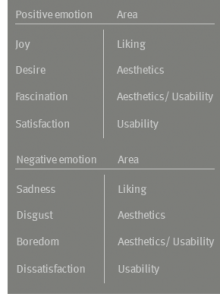The Internet has evolved from a source of information to a rich media and social experience. Websites no longer just intent to prevent negative emotions (usability), but intent to delight and engage a user. LEMtool is a web based self-report tool (developed by SusaGroup, researched at University of Twente) to run quick studies to uncover the emotional impact of your website, prototype or visual concept. Now you can start designing for emotion.
LEMtool makes it possible to uncover the emotional impact of a design. You can test sketches, mock-ups, early designs, websites or any other image. In other words: testing at any stage in the design process is possible. With LEMtool it is even possible to evaluate live websites or working prototypes on a password protected location.
Also, have a look at the LEMtool features. Below, I will describe more extensively what science is behind the development of LEMtool.
The science behind LEMtool
Optimizing usability is the basis for every great user experience. Apart from the actual usability of a website, there is also the usability as perceived by the user. Several studies indicate a strong relation between perceived usability and the visual appeal of a website (“attractive things appear to work betterâ€). This seems to suggest that the main purpose of visual design in any interface, is a functional one, aimed at improving usability.
Emotion is therefore a vital additional dimension to current usability studies.
Indeed, efficient and effective communication with the user through the appropriate visual design of an interface, is a goal most designers seek to accomplish. Nonetheless, visual appeal is not purely perceived as functional.
Research has indicated that there are attributes in an interface that do not necessarily relate to usability, but to the pleasure that a high visual appeal interface might evoke in its users.
What links visual appeal to affect (and emotion) is that objects are not only categorized based on perceived features of the object, but can also be emotionally categorized. This means that objects that evoke similar emotions can be categorized based on the similarity of these emotions.
Emotion is therefore a vital additional dimension to current usability studies.
 Web relevant emotions
Web relevant emotions
Identifying specific emotions that are most relevant in web- and media experiences helped build a more relevant basis for the LEMtool.
In an experiment using free-response tasks for commenting on website, participants consistently reported most on three areas, namely; aesthetics (visual stimuli pleasuring or offending the senses), usability (perception of effectiveness and efficiency of an interface based on goals and expectations), and liking (an overall judgment of the user’s interactive experiences). Especially the areas of aesthetics and usability are central to the evaluation of interfaces in general.
In the table on the right, you see the final eight emotions and to which area they relate.
 Why work with a cartoon character?
Why work with a cartoon character?
The LEMtool has been developed to depict emotions in the clearest, most recognizable way. In order to achieve this, LEM – a cartoon character, has been developed that shows eight caricatured expressions of emotions3. Facial caricaturing (reduction of facial information redundant to the expression and exaggeration of the essential components) has been found to enhance the recognizability of emotions.
Why not add the words to explain the expression?
We deliberately do not explain which emotions are expressed by the character. This ‘non-verbal approach’ actually adds reliability to the tests. Often, people are feeling similar emotions, but refer to it with different words. With our scientifically validated cartoon characters you surpass the verbal word-significance discussion.
A great benefit of this approach is that it can be used cross-culturally: Between cultures, there are tons of small differences between words that are used to express emotions.
 We might feel the same emotion, but call it differently
We might feel the same emotion, but call it differently
– How the LEMtool avoids the verbal word-significance discussion
Our research shows that even though different people use different words to express a specific emotion, they choose the same cartoon character expression because it best represents their felt emotion. This illustrates that these people are actually feeling the same, but merely call it differently.
Self-report
Recent technological advances have made it possible to measure people’s ‘emotions’. What these advancing approaches have in common is a focus on behavior (facial expression and bodily gestures) or physiological metrics (heart rate, skin conductance, EMG, pupil dialation). Even though the progress in technology helps improve the used instruments, there are some major limitations, especially in measuring web and media emotions.
- Physiological approaches mainly measure ‘affective arousal’ and do not provide insight in whether it is positive or negative, let alone which specific emotion is felt. To know if a user feels boredome or desire, you will have to ask them. LEMtool is perfect for that.
- The majority of instruments for behavioral or physiological emotion measurement (still) require lab setups which can be obtrusive for the user and are definitely more time-consuming and expensive. LEMtool provides a web based environment; users are asked to participate online and experiments can be setup really quickly.
- The abovementioned instruments are not able to provide detailed information on the exact spots and areas that evoke the emotions with the users. LEMtool’s main objective is to give insight in the the emotion, the area and the appraisal
- If you want to measure emotions, the abovementioned alternatives do not provide the insights that can help improve the design emotionally. In a user experience there is another important factor: the overal perception of the experience and perceived usability of the product. It is not possible to measure perception ‘objectively’ and in this case self-report can be especially helpful. LEMtool not only asks users to point out specific area’s and the emotions they evoke, but also WHY it makes them feel these. A result is vital insight in the perception the user has of the website.
More information can be found at the tool specific website www.lemtool.com
Related publications and references
Huisman, G. (2011). Visual Appeal and Affect in Websites. Unpublished master’s thesis, University of Twente, Enschede, the Netherlands.
Hout, M. (2003). Interactive Products and User Emotions. Unpublished master;s thesis, University of Twente, Enschede, the Netherlands
Capota, K, Hout, M., van & Geest, T.M., van der (2007). Measuring the Emotional Impact of Websites. A Study Combining a Dimensional and Discrete Emotion Approach in Measuring Visual Appeal of University Websites. In Designing Pleasurable Products and Interfaces Conference. 2007 . Helsinki.
Huisman, G. (2009). LEMtool – Visual Emotion Measurement in Digital Media. Unpublished bachelor’s thesis, University of Twente, Enschede, the Netherlands.












Justin MartinezVisitor
Marco,
Thanks for sharing. This application looks really useful to improving websites on an emotional level. Anything that can help uncover how a user is feeling as they interact with a website is going to provide crucial feedback to consider when making design improvements to the user interface. Look forward to seeing how the application develops over time.
Regards,
Justin